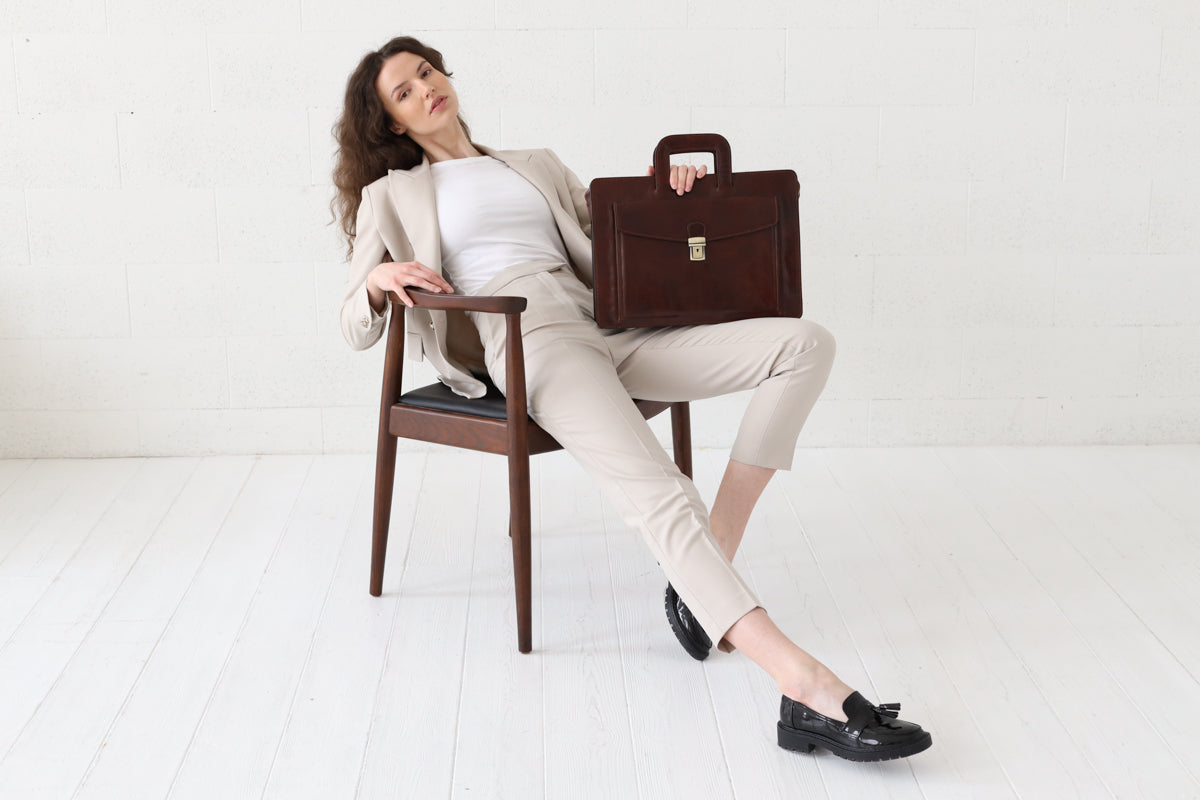Since I have been staying at home a lot more lately (for obvious reasons) I have been watching a lot more TV than I usually do. Of course, there is a lot more I can do like work out or do crafts however sometimes it is so great just to be a couch potato. Since I watch more TV at least I try to watch some really good movies. While watching the classics I noticed (considering the industry I’m in) how many of them have characters carry a leather briefcase. I started thinking more and more about it and these are the insights I decided to share.
A narrow hard-sided rectangular box for ages has been enticed to an image of a serious man always running late due to his hectic schedule. It is the briefcase in the world of bags that has been reflecting the most businessmen and women like the legendary and charming Jordan Belfort (played by Leonardo DiCaprio) in The Wolf of Wall Street. Though modern fashion keeps breaking the standards by matching unmatchable clothes and accessories, cinema tends to remain on the traditional side. Why is it so? Each movie has its aim to picture a concrete historical or imaginary context. When it comes to fashion, this is where costume designers intervene. Their definite objective is to realize the visualizations of the director and screenwriter. Therefore, a leather satchel most commonly helps depict a classy man in a suit, even in a modern-day world. As in the 2015 comedy-drama Intern (directed by Nensi Meyjers), where one of the lead characters, intern Ben, (played by Robert DeNiro), shows up in an old-school suit carrying a vintage-style briefcase meanwhile his colleagues are dressed slightly more casually. The portfolio itself appears to create not only a prestigiously immaculate image, but also swiftly highlights amid electronic gadgets, backpacks, and trendy 21st-century bags.
Nonetheless, a leather portfolio bag is not necessarily just an accessory in the world of cinema. Sometimes it takes a meaningful part in a story. Many of us know the mysterious 666 briefcases from Quentin Tarantino's legendary crime classic Pulp Fiction. In a search for a concealed message, attentive viewers were concerned and curious about what it contained. Some tell it was a soul, whereas others contradict the precedents by interpreting it as the director's trick so that the viewers pick the object that, according to them, suits them best.
Another great example is the 2012 Brian Klugman's and Lee Sternthal’s movie Words. The protagonist Rory finds his life-changing antique briefcase that hides a wonderfully written manuscript that defines his success as a writer. But not always the portfolio carries something purposeful to the owner. Contrarily the movie Falling Down, directed by Joel Schumacher, shows how the briefcase can create an erroneous impression about its owner. The briefcase accompanies William "D-Fens" Foster (Michael Douglas) during the first episodes of the movie. At first sight, it appears to be more valuable than it is, especially in the scene where the main character is detained and threatened by two gang members who demand his portfolio. Suddenly we find out that the portfolio, which might have contained billions of dollars, was only carrying his lunch.

The fantasy genre takes the role of the briefcase to another level. Newton Scamander’s (Eddie Redmayne) briefcase is also a detail to notice in an adaptation of J.K. Rowling's best-seller Fantastic beasts and Where to Find Them. A spacious and worn briefcase is unlike the other ones – it is magical. Bewitched with an Extension Charm, the box permitted him to house plenty of magical beasts. It is no extraordinary that (as the story tells) in 1926, a briefcase was one of the most trending accessories, namely for men. Hence, the movie perfectly reflects it.

Whether consciously or not, movies undoubtedly add to modifying our thinking and lifestyle. There have been occasions when successful blockbusters proved to dictate the upcoming trends by having such a significant impact on viewers. For instance, Bambi has decreased hunting rates, and the revival of Clueless supplemented wardrobes of teenage girls with 90s fashion. Although a portfolio bag is a timeless accessory to pick up on and it is always trending, cinema can influence the look you are creating with it and broaden the range of ideas on how to do it. Whereas in terms of movies, unlike clothing, such accessory, is not necessarily just a detail supporting the cinematography and design. In a modern comedy, it may outstand the character. In crime or fantasy dramas, it can vividly represent an authentic period of history and, last but not least, be the axis of a story.
Written by: Mintautė Berulytė


